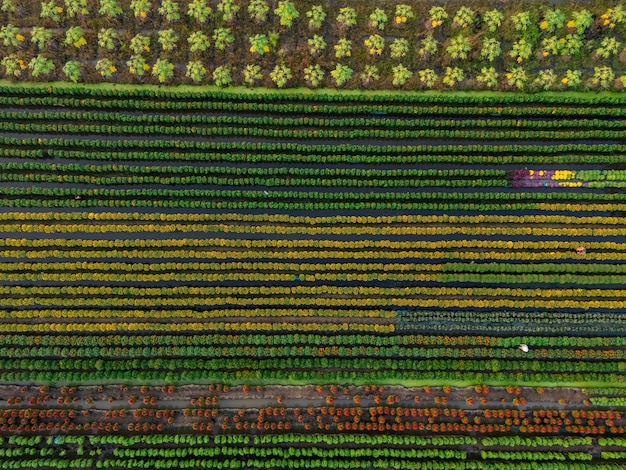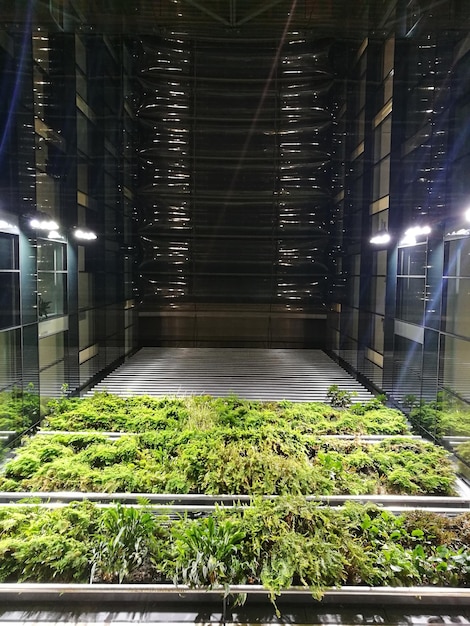Latest Trends in US Food & Agriculture: A Guide to Healthier Eating

Discover the latest trends in US food and agriculture, including regenerative agriculture, vertical farming, and the rise of plant-based diets, and learn how these innovations can help you adopt healthier eating habits.
Are you curious about the future of food in the United States? The landscape of US food and agriculture is constantly evolving, influenced by technology, sustainability concerns, and a growing focus on healthy eating. Let’s explore what are the latest trends in US food and agriculture and how can you eat healthier amidst these changes.
Understanding the Evolving Landscape of US Agriculture
The agricultural sector in the US is undergoing significant transformations. These changes are driven by a combination of factors, including consumer demand, environmental concerns, and technological advancements. Understanding these shifts is the first step towards making informed food choices.
From innovative farming techniques to changing dietary preferences, the future of food is being shaped right now. Let’s delve deeper into some key areas.
Technological Innovations in Farming
Technology is revolutionizing agriculture, making it more efficient and sustainable. Precision agriculture, for instance, uses data and sensors to optimize irrigation and fertilizer application, reducing waste and environmental impact.
- Precision Agriculture: Using sensors and data analytics to optimize farming practices.
- Automation: Employing robots and AI to handle tasks like planting, harvesting, and weeding.
- Biotechnology: Developing crops that are more resistant to pests and diseases, reducing the need for pesticides.
These technologies not only increase productivity but also contribute to more sustainable farming practices.

The Rise of Sustainable and Regenerative Agriculture
As awareness of environmental issues grows, sustainable and regenerative agriculture practices are gaining traction. These approaches focus on improving soil health, reducing carbon emissions, and promoting biodiversity.
Regenerative agriculture goes beyond simply sustaining the environment; it aims to actively restore and improve it.
Key Principles of Regenerative Agriculture
Regenerative agriculture encompasses a range of practices designed to enhance the health of the land and ecosystems. These principles are essential for creating a more resilient and sustainable food system.
- Minimal Soil Disturbance: Reducing tillage to protect soil structure and prevent erosion.
- Cover Cropping: Planting cover crops to improve soil health and prevent weed growth.
- Crop Rotation: Rotating crops to break pest cycles and improve soil fertility.
By adopting these practices, farmers can improve soil health, reduce reliance on synthetic inputs, and enhance the long-term productivity of their land.
These methods, while promising, require a shift in mindset and investment in new techniques.
Vertical Farming and Urban Agriculture
With increasing urbanization, vertical farming and urban agriculture are emerging as innovative solutions to bring food production closer to consumers. These methods can reduce transportation costs and environmental impact.
Vertical farms utilize stacked layers of growing space, often indoors, allowing for year-round crop production regardless of weather conditions.

Benefits of Vertical Farming
Vertical farming offers numerous advantages, including reduced water usage, higher yields, and the ability to grow crops in urban areas, and it can help in providing fresh produce in food deserts.
Here are some reasons why vertical farming holds potential.
- Reduced Water Usage: Recycling water and using hydroponic or aeroponic systems to minimize water consumption.
- Higher Yields: Growing crops in a controlled environment to maximize productivity.
- Local Food Production: Bringing food production closer to consumers, reducing transportation costs and emissions.
However, the initial investment costs for setting up vertical farms can be significant.
The future of food production may well include more of these innovative systems integrated into our cities.
The Growing Popularity of Plant-Based Diets
Plant-based diets are becoming increasingly popular, driven by concerns about health, animal welfare, and the environment. This trend is influencing the food industry to develop more plant-based alternatives to meat and dairy products.
A plant-based diet emphasizes whole, minimally processed foods derived from plants, such as fruits, vegetables, grains, legumes, nuts, and seeds.
Incorporating More Plant-Based Foods
Adopting a plant-based diet can have numerous health benefits, including reduced risk of heart disease, type 2 diabetes, and certain types of cancer. Here are a few things to keep in mind.
- Focus on Whole Foods: Incorporate a variety of fruits, vegetables, whole grains, and legumes into your meals.
- Explore Plant-Based Protein Sources: Experiment with tofu, tempeh, lentils, and chickpeas as alternatives to meat.
- Read Labels Carefully: Be mindful of added sugars, sodium, and unhealthy fats in processed plant-based products.
Transitioning to a more plant-based diet can be a gradual process, starting with small changes and building from there.
Consumer demand is driving innovation in plant-based food, making it more accessible and appealing.
The Importance of Local and Seasonal Eating
Eating local and seasonal foods offers numerous benefits, including supporting local farmers, reducing the environmental impact of transportation, and enjoying fresher, more flavorful produce.
Seasonal eating means consuming foods that are harvested during their natural growing season, ensuring optimal flavor and nutritional value.
Benefits of Buying Local
Buying local food supports local economies, reduces transportation emissions, and provides access to fresher, healthier produce. Consider these benefits.
Supporting local farmers helps create jobs and strengthens the community.
- Supports Local Economies: Investing in local businesses and creating job opportunities.
- Reduces Transportation Emissions: Minimizing the distance food travels from farm to table.
- Provides Fresher Produce: Enjoying fruits and vegetables at their peak ripeness and nutritional value.
Finding local sources of food can be as simple as visiting a local farmers market or joining a Community Supported Agriculture (CSA) program.
When you eat with the seasons, you’re likely to experience more variety in your diet, too.
Navigating Food Labels and Making Informed Choices
With so many food products on the market, it’s essential to understand how to read food labels and make informed choices that align with your health goals. Confusing labels can make it difficult to choose healthier options.
Understanding the information provided on food labels can empower you to make healthier decisions.
Key Elements of a Food Label
Food labels provide valuable information about the nutritional content and ingredients of a product. Knowing what to look for can help you make healthier choices, consider these aspects.
- Serving Size: Pay attention to the serving size listed on the label, as all the nutritional information is based on this amount.
- Nutrient Information: Check the amounts of calories, fat, sugar, and sodium per serving.
- Ingredient List: Look for whole, recognizable ingredients and avoid products with excessive additives or artificial ingredients.
By carefully reviewing food labels, you can make more informed decisions about the foods you consume.
The more you understand the labels, the easier it is to make choices that align with your health goals.
| Key Area | Brief Description |
|---|---|
| 🌱 Regenerative Agriculture | Practices that improve soil health and reduce environmental impact. |
| 🏙️ Vertical Farming | Growing crops in stacked layers, often indoors, for higher yields and reduced water use. |
| 🌿 Plant-Based Diets | Increasing popularity due to health, ethical, and environmental concerns. |
| 🚜 Local & Seasonal Eating | Supports local farms, reduces emissions, and offers fresher produce. |
Frequently Asked Questions
▼
Regenerative agriculture is a farming approach that focuses on improving soil health, increasing biodiversity, enhancing water cycles, and sequestering carbon from the atmosphere. It aims to restore and improve ecosystems.
▼
Vertical farming can enhance food security by producing crops year-round in controlled environments, reducing reliance on weather conditions and transportation. This ensures a more consistent and reliable food supply.
▼
A plant-based diet can offer numerous health benefits, including a reduced risk of heart disease, type 2 diabetes, certain cancers, and obesity, due to its high fiber, vitamin, and mineral content.
▼
Eating locally and seasonally supports local farmers, reduces transportation emissions, and provides access to fresher, more nutritious produce. It promotes sustainable and responsible food consumption habits.
▼
To navigate food labels effectively, pay attention to serving sizes, nutrient information (calories, fat, sugar, sodium), and the ingredient list. Choose products with whole, recognizable ingredients and minimal additives.
Conclusion
Staying informed about the latest trends in US food and agriculture empowers you to make healthier, more sustainable choices. By understanding the impact of regenerative agriculture, vertical farming, plant-based diets, and local eating, you can contribute to a more resilient and equitable food system while improving your own well-being.






